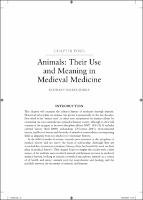Chapter 4 Animals
Their use and Meaning in Medieval Medicine
Author(s)
Walker-Meikle, Kathleen
Collection
WellcomeLanguage
EnglishAbstract
This chapter will examine the cultural history of medicine through animals. Historical scholarship on animals has grown exponentially in the last decades. Described as the ‘animal turn’, it offers new perspectives on human culture by examining the roles animals have played in human society, although it often still remains at the margins or between disciplines (Ritvo 2007: 118–22). It includes cultural history (Resl 2009), archaeology (O’Connor 2013), environmental history, intellectual history and the study of animals as commodities, encompassing fields as disparate from zoo studies to evolutionary history.
In the field of medieval studies, animals have remained at the periphery of medical history and are rarely the focus of scholarship. Although they are accorded due attention in veterinary history, there has been little work on their place in medical history.1 This chapter hopes to inspire the reader with a brief survey of the multiple ways in which animals and humans intersect in medieval medical history, looking at animals as medical metaphors; animals as a source of ill health and injury; animals used for nourishment and healing; and the parallels between the treatment of animals and humans.


 Download
Download